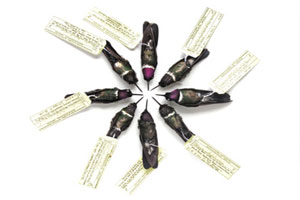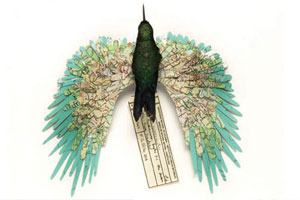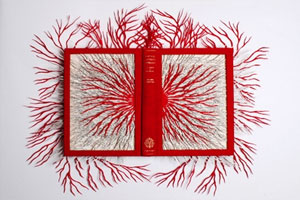Barbara Wildenboer: Canaries In The Coal Mine
The venue - high ceilinged, white walled and sparse- presents standard minimalism, which, while stark, offers nothing stiff or sterile. The atmosphere was loose and languid, with people milling and mingling around the wine and meandering around the installations. I grabbed a glass of surprisingly good Cabernet, as dry as the droll quips overheard in the vibrant conversations around me, and began to investigate further. Despite the warm hubbub it seemed that each separate installation commanded an immediate and communal awed silence.


The concept of "solastalgia"
Canaries In The Coal Mine is Barbara Wildenboer's sixth solo exhibition. In it she uses photography, mixed media, paper construction and altered books to explore the concept of "solastalgia", a term recently coined to describe the nostalgia particularly associated with a sense of "place": the homesickness or melancholy perhaps experienced by an emigrant on realising that his former home environment is under threat.
This idea of transience, non-permanence and the constancy of restlessness are recurrent themes in Wildenboer's work. Her debut 2007 collection Absence/Presence (winner of the Public Vote Prize at the 2011 African Art Prize Competition) offered longing, loss and loneliness as its central motifs. Similarly, the themes of disappearance and the temporal nature of all things are prevalent in Canaries In The Coal Mine.
But whereas Wildenboer previously appeared to be inspired by personal experience, in her new collection the source of this idea of melancholy is non-specific and allusive. There is a universality in her three-dimensional paper constructions, in which she uses sections of non-specific maps to contextualize her work as a global condition. Her various techniques, supported by the universally comprehensive signifier of a central bird motif in each piece allow the viewer to engage with the ideas of melancholy and displacement as a collective condition rather than as a personal experience or one limited to a specific geographic, social or cultural context.


The shared silence induced by each artwork possibly stems from this evocation of a basic collective consciousness: a feeling of solidarity with humanity and the environment. Each piece develops the motif of a bird or the abstraction of a bird's wings and explores the relationship to its visual microcosm. The piece "Burning Bridges and Making Fences" - an animated mixed media piece - uses photographic print, pins and silver thread in three separate circular installations of differing sizes in which a delicate bird is suspended in a dark, thunder-struck sky, apparently contained by a fence. Skeletal figures of threatening prehistoric birds lurk on the edges creating an arresting and thrilling effect of suspense and foreboding.
An electronic piece, "There's no Place like Home", makes the viewer feel like a postmodern Dorothy who is not sure if her red slippers or her home ever existed. The piece is slow moving and ethereal and the bird's wing imprint roams aimlessly through a conceptual photographic map of a flat world where the only specifics given are the Indian and Atlantic Oceans.
Questioning of all that is set and permanent
But perhaps the conceptual characteristic most synonymous to Wildenboer as an artist is her process of book alteration and her framed works entitled "Psicologia Bilogia". These present the viewer with layers of intricate and delicate patterns, embedded in, and created from, the book's pages. Through this process of textual alteration Wildenboer extends her questioning of all that is set and permanent. She explores the idea of the authority of text that, despite its responsibility to chronicle history and narrative, can be easily manipulated.


There are just eight pieces making up this exhibition, each ranging in size and medium, but all demanding individual attention for their delicacy and the simplicity of their form, aesthetic and content, which belies their extraordinary attention to detail. Wildenboer's Canaries In The Coal Mine makes you feel that you have shared far more than a nod and a "hmmmm, yes, interesting" with your fellow art-goers. Apart from being left in awe at the visual and conceptual beauty, delicacy and insight in her work Wildenboer's collection is emotionally evocative and extremely accessible. Thus, the excited, expectant and responsive attendance of her opening night comes, retrospectively, as no surprise.
Article previously published on www.whatsonincapetown.com
For more info go to www.erdmanncontemporary.co.za